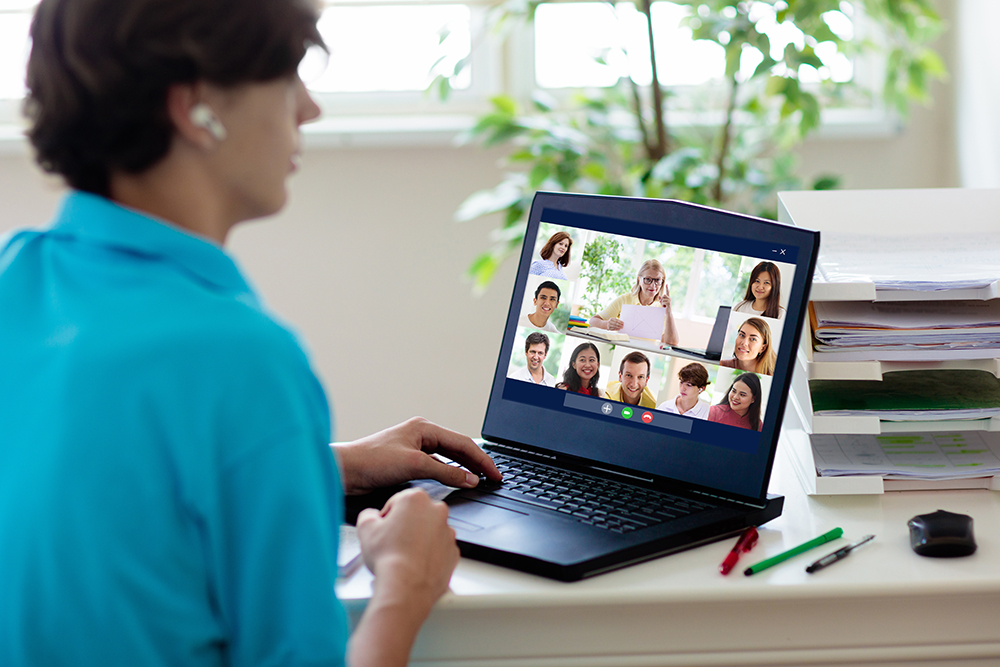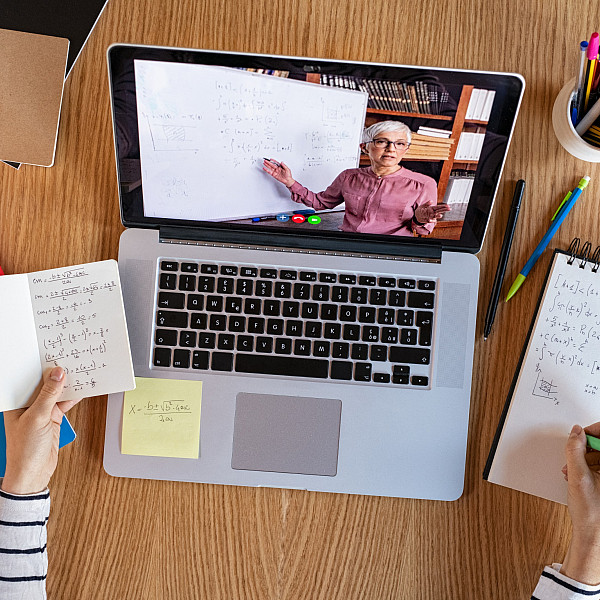News
Keeping an Open Mind: The Opportunities of Remote Learning
September 17, 2020
September 17, 2020
Open gallery

When you think about the phrase online learning, what pops into your head? Snore-inducing webinars with no opportunity to interact or even submit questions? A recorded lecture that keeps disconnecting midsentence (“buffering … buffering …”)? A narrated PowerPoint in which the slides are filled with far too much text in “creative” fonts against eye-straining background colors and a voiceover whose pace is way too fast or slow? A course that prevents you from proceeding past any single page until the snail-like timer runs down and then baffles you with a poorly written reading-comprehension question?
Many of us have experienced such frustratingly poor examples of remote courses. And most liberal-arts colleges, including Southwestern, have long resisted the sway of distance learning because they pride themselves on close bonds between professors and undergraduates, the residential experience, and immersive education. So when the COVID-19 pandemic forced universities large and small, public and private to transition rapidly to remote teaching and learning this past March, many faculty and students understandably balked.
Still, distance education, whether you love it or hate it, has existed for decades, and online learning has made significant strides forward since the Internet became public in 1991—and even greater leaps in just the past 10 years. Well beyond stilted webinars and passively viewed presentations, the field has grown to encompass game-based courses, multimedia archives, interactive storytelling and branching scenarios (think Choose Your Own Adventure), virtual labs and studios, and robust real-time and asynchronous chat forums. For many populations, distance learning is their education format of choice: it’s often self-paced, it enables study from any location that has Internet access, it better accommodates the schedules of adult learners with families and/or jobs, it can broaden students’ technological skills, it prepares students for remote jobs (a growing trend even before COVID-19), and it can virtually connect students and faculty from across the globe.
Online learning offers an additional benefit: it opens up an experimental space for innovating their pedagogy.
And for many teachers and professors, including faculty at SU, online learning offers an additional benefit: it opens up an experimental space for innovating their pedagogy.
An opportunity for teaching innovation
“There’s a negative perception of online learning for multiple reasons: in the spring, we made the switch really quickly, and not everyone did a good job. [Students and faculty] had negative experiences at other universities and at larger schools where they don’t connect with students as well,” says Professor and Garey Endowed Chair in Chemistry Maha Zewail-Foote. Hybrid and online courses this fall at SU, however, will rise above expectations, she believes, in large part because of the close mentoring relationships faculty and students enjoy. “At Southwestern, the in-person experience is who we are. But we can take what we’re good at and are able to transition that to the remote environment… . I like the creativity. I’m excited because it’s an opportunity!”
Most Southwestern professors expressed deep skepticism of online learning back in March and April, but the mood for many has changed to cautious optimism six months later thanks to a summer filled with conversations and training workshops to improve their remote-teaching practices. By collaborating with the staff at the Center for Teaching, Learning, and Scholarship and working independently, faculty have worked diligently to improve on the remote courses they were forced to create in only two weeks’ time last spring: they have revised their syllabi to prepare for all teaching formats, enhanced their online course development, and become more comfortable with learning technologies so that students will have even greater access to their instructors this fall, whether they are learning on campus or remotely. Their experiences mirror that of writing students who learn more about the conventions of different genres and the field of literature more broadly by being asked to re-present the same topic or theme in different forms, such as a short story, a poem, and a play. Similarly, professors are reassessing their approaches to teaching and enhancing student learning overall by translating their courses into the new context of online education.
But Zewail-Foote is one of the faculty members who approached even her spring classes with the enthusiastic spirit of taking on a challenge and adapting to new circumstances. While teaching Advanced Biochemistry Lab and The Biochemistry of Nucleic Acids last semester, she made it her goal to develop online assignments that still achieved the original learning objectives of her classes. She also used digital resources—such as whiteboards, videos, video conferencing, real-time collaboration tools, and chat rooms—to continue cultivating the sense of community that characterizes her in-person classes. Although mediated by screens rather than interacting face-to-face, she remarks, “I was still able to connect with them, and it was still fun,” she remarks. Her students, she says proudly, remained engaged, active, and motivated.
In July, the chemistry professor published a paper describing her positive experiences, “Pivoting an Upper-Level, Project-Based Biochemistry Laboratory Class to Online Learning during COVID-19: Enhancing Research Skills and Using Community Outreach to Engage Undergraduate Students.” The publication appears in a recent issue of Journal of Chemical Education that focuses on online teaching.
Zewail-Foote, who is also a visiting scholar at the Dell Pediatric Research Institute at the University of Texas at Austin, reveals that the online environment can afford certain opportunities that she could not take advantage of in her brick-and-mortar classrooms, such as introducing her students to instruments or procedures that are not available on campus. There are limitations of the hands-on activities she would normally facilitate in a lab class, of course. But regardless of the venue, her focus remains on students learning how to think like scientists. “I can’t do in-person experiments, but I can help students learn about science and think about how to solve problems, report and describe the data, and present their findings,” she says. “And there are multiple ways to solve a problem, so they still get to learn through inquiry, creativity, and curiosity.”
The online environment affords certain opportunities that [professors] could not take advantage of in [their] brick-and-mortar classrooms.
Zewail-Foote’s article also includes her insights on developing a community outreach project, Making a Difference, for the class. In the midst of the pandemic, the chemistry professor and her students switched gears by asking themselves, “How can we help people?” They then channeled what they had already learned into serving their local neighborhoods. The students could work alone or in groups and choose small or large projects; the primary requirement was that it had to relate to science. Because they were designing their projects remotely, Zewail-Foote notes, “Everyone could do what they wanted to do. They could pursue their individual passions.” And because they were studying remotely, the students could extend their volunteer engagement to the various communities they were living in—across Texas and across the nation.
The interactivity of STEM courses today
While reflecting on her experiences with remote teaching and conversations with colleagues, Zewail-Foote praises her fellow STEM faculty especially, crediting their ability to move their classes online because of the interactive approach they take to teaching even during a traditional semester. In K–12 and higher-ed circles, this is known as a flipped classroom, in which students explore introductory material on their own and class time is reserved for working through more challenging applications and problem-solving. Long lectures with professor-led demonstrations and limited discussion are no longer the norm. “Chemistry and biology class is not the same as 20 years ago!” she laughs.
Zewail-Foote herself has been using this more inquiry-based and active-learning approach for years: she creates short videos, five to eight minutes long apiece, for her students to view at home. She also assigns introductory readings and worksheets with questions. Then, in class, instead of monologuing while her students sit, listen, and take notes, Zewail-Foote’s students ask questions, work through problems together, and synthesize ideas so that they are prepared to engage in more challenging homework the next evening. It’s a teaching model that trains students to be scientists by doing science the way that STEM scholars research and experiment—and one that earned her recognition in a Chronicle of Higher Education article in 2013.
Zewail-Foote asserts that the implementation of flipped classrooms made the switch to hybrid or all-online learning more seamless. “People picture webinars, but a remote class at Southwestern is good,” Zewail-Foote asserts. “The lab part is challenging because they don’t do hands-on work, but SU does it well. The students preview [what they’re learning], they practice it, and they master it. The Southwestern Experience is engaging, and even when the students are online, they’re going to be creative, they’re going to be inquisitive, and they’re going to reach out to the community. None of that is taken away.”
“The Southwestern Experience is engaging, and even when the students are online, they’re going to be creative, they’re going to be inquisitive, and they’re going to reach out to the community.”
That dedication to curiosity, inquiry, and public service will remain crucial as COVID-19 continues to make its rounds throughout the country and across the world. Cursory glances at social media, for example, underscore how learning science and scientific literacy (as well as information and media literacy) is more important than ever, not just as an intellectual passion among researchers but also for the health and safety of the public. “Tackling the coronavirus is going to depend on science, and so we need science—we need to learn science,” Zewail-Foote observes. “I’ve been teaching a long time, and I finished school many years ago, but does that mean I’m done learning? No! Science is changing. The world is changing.” While teaching last spring, she was able to model the very outcomes of a scientific education in the midst of a global health crisis, such as knowing how to evaluate the validity and quality of sources, read and understand scientific articles, develop questions, and find the right people or resources to consult. Those skills are learned and emulated by her undergraduates. “Students don’t always realize that I’m trying to teach them how to learn so that they can learn forever, but that is what they are going to learn here,” she says, “and we can merge that Southwestern Experience with remote learning in a positive way.”
In faculty we trust
For Zewail-Foote, it’s important to remind ourselves that not all educational experiences are held equal: the student (and faculty) experience can differ wildly between K–12 and higher education, between community colleges and four-year universities, between large state schools and private colleges, and even within individual institutions. Indeed, as those of us who have studied and taught in a variety of educational settings can say from experience, the quality of instruction and learning varies regardless of whether it takes place in a classroom, through distance learning, or in a hybrid format. Any class’s success instead depends on such factors as careful course design, the instructor’s depth and breadth of knowledge, their ability to engage students, the students’ level of motivation and participation, the assignment of meaningful activities, and mutual respect among students and between students and their teacher.
Luckily, students can rely on their SU professors to fulfill their commitment to providing meaningful and memorable educational experiences regardless of whether classes take place in person, online, or both. Southwestern is now in its second week of offering mostly in-person courses, but more than 30% of courses are currently remote only, with many students having specifically requested the online option. Fortunately, Southwestern faculty have prepared for all formats. And, as Zewail-Foote’s publication and experience illustrate, those classes, even if online, will continue to be as dynamic, engaging, and interactive as the in-person courses the university is known for.
















